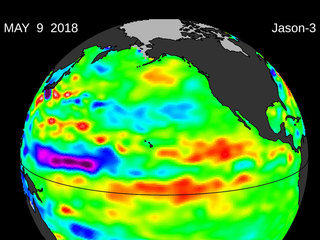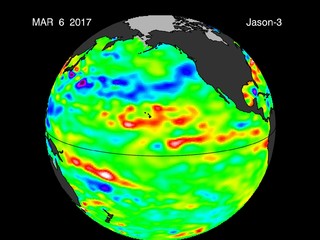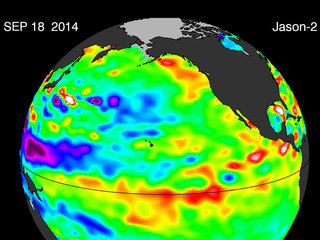News | October 8, 1997
El Niño spreads northward along coast of North America

This image of the Pacific Ocean was produced using sea surface height measurements taken by the U.S./French TOPEX/Poseidon satellite. The image shows sea surface height relative to normal ocean conditions on Oct. 3, 1997 as the warm water associated with El Niño (in white) spreads northward along the entire coast of North America from the equator all the way to Alaska. The warm water pool in tropical Pacific resulting from El Niño seems to have stabilized. The white and red areas indicate unusual patterns of heat storage; in the white areas, the sea surface is between 14 and 32 centimeters (6 to 13 inches) above normal; in the red areas, it's about 10 centimeters (4 inches) above normal. The surface area covered by the warm water mass is about one and one-half times the size of the continental United States. The added amount of oceanic warm water near the Americas, with a temperature between 21 and 30 C (70 to 85 F), carries the amount of heat equal to 100 times the amount of fossil fuel energy consumed by the entire U.S. population during one year. The green areas indicate normal conditions, while purple (the western Pacific) means at least 18 centimeters (7 inches) below normal sea level.
The El Niño phenomenon is thought to be triggered when the steady westward blowing trade winds weaken and even reverse direction. This change in the winds allows a large mass of warm water (the red and white area) that is normally located near Australia to move eastward along the equator until it reaches the coast of South America. The displacement of so much warm water affects evaporation, where rain clouds form and, consequently, alters the typical atmospheric jet stream patterns around the world. Using these global data, limited regional measurements from buoys and ships, and a forecasting model of the ocean-atmosphere system, the National Centers for Environmental Prediction (NCEP) of the National Oceanic and Atmospheric Administration (NOAA) has issued an advisory indicating the presence of a strong El Niño condition throughout the coming winter.
For more information, please visit the TOPEX/Poseidon project web page at http://topex-www.jpl.nasa.gov/





